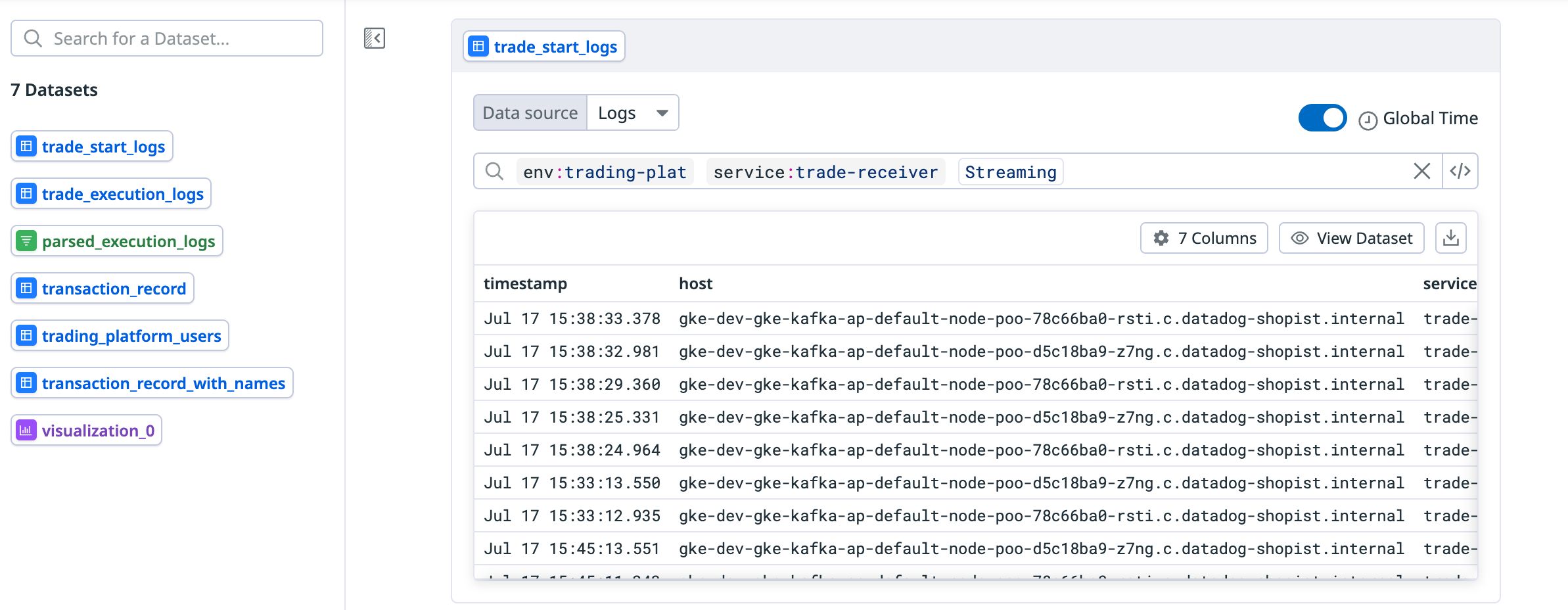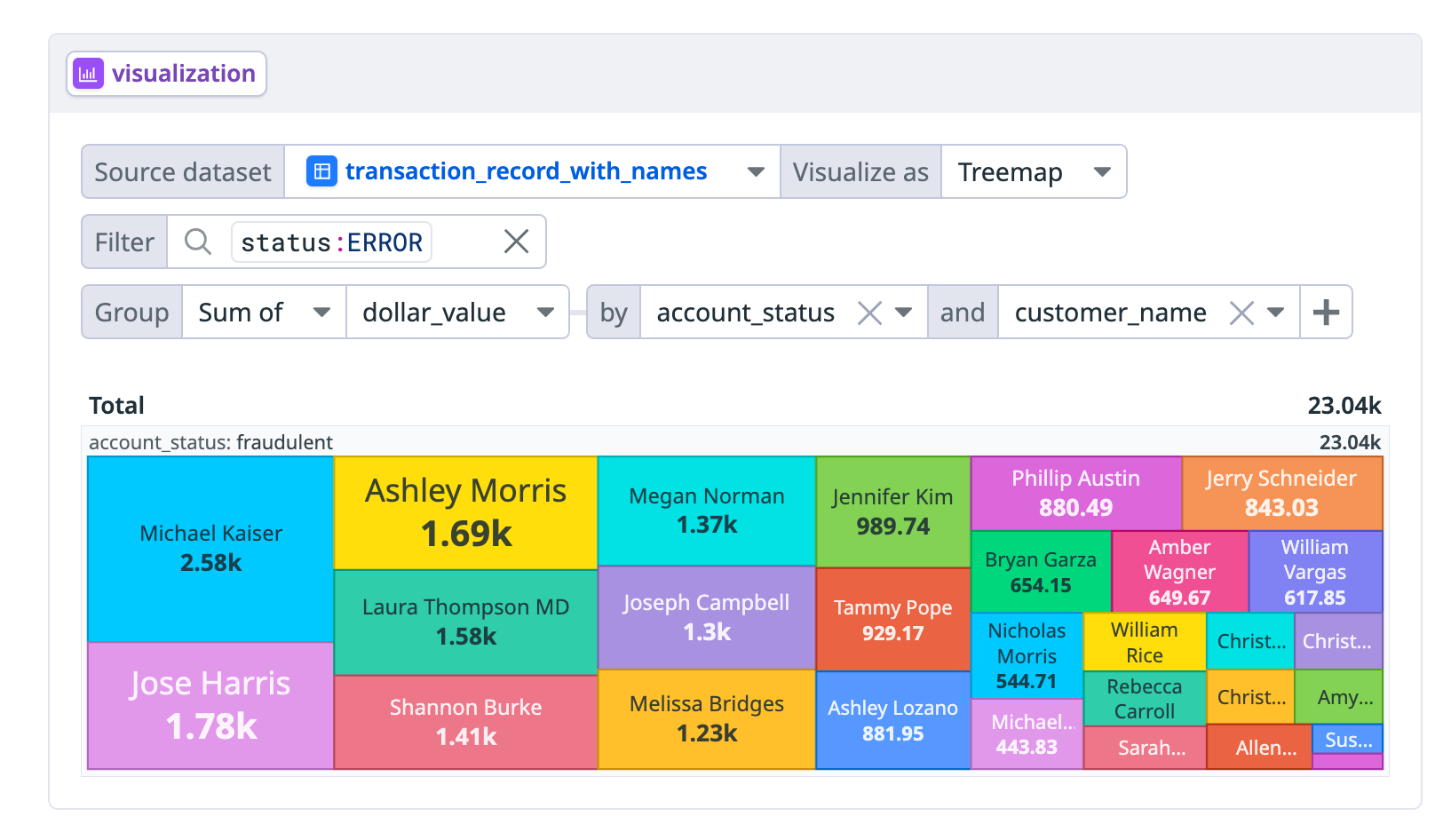- 重要な情報
- はじめに
- Datadog
- Datadog サイト
- DevSecOps
- AWS Lambda のサーバーレス
- エージェント
- インテグレーション
- コンテナ
- ダッシュボード
- アラート設定
- ログ管理
- トレーシング
- プロファイラー
- タグ
- API
- Service Catalog
- Session Replay
- Continuous Testing
- Synthetic モニタリング
- Incident Management
- Database Monitoring
- Cloud Security Management
- Cloud SIEM
- Application Security Management
- Workflow Automation
- CI Visibility
- Test Visibility
- Intelligent Test Runner
- Code Analysis
- Learning Center
- Support
- 用語集
- Standard Attributes
- ガイド
- インテグレーション
- エージェント
- OpenTelemetry
- 開発者
- 認可
- DogStatsD
- カスタムチェック
- インテグレーション
- Create an Agent-based Integration
- Create an API Integration
- Create a Log Pipeline
- Integration Assets Reference
- Build a Marketplace Offering
- Create a Tile
- Create an Integration Dashboard
- Create a Recommended Monitor
- Create a Cloud SIEM Detection Rule
- OAuth for Integrations
- Install Agent Integration Developer Tool
- サービスのチェック
- IDE インテグレーション
- コミュニティ
- ガイド
- Administrator's Guide
- API
- モバイルアプリケーション
- CoScreen
- Cloudcraft
- アプリ内
- Service Management
- インフラストラクチャー
- アプリケーションパフォーマンス
- APM
- Continuous Profiler
- データベース モニタリング
- Data Streams Monitoring
- Data Jobs Monitoring
- Digital Experience
- Software Delivery
- CI Visibility (CI/CDの可視化)
- CD Visibility
- Test Visibility
- Intelligent Test Runner
- Code Analysis
- Quality Gates
- DORA Metrics
- セキュリティ
- セキュリティの概要
- Cloud SIEM
- クラウド セキュリティ マネジメント
- Application Security Management
- AI Observability
- ログ管理
- Observability Pipelines(観測データの制御)
- ログ管理
- 管理
Getting Started with Notebooks Analysis Features
このページは日本語には対応しておりません。随時翻訳に取り組んでいます。
翻訳に関してご質問やご意見ございましたら、お気軽にご連絡ください。
翻訳に関してご質問やご意見ございましたら、お気軽にご連絡ください。
Join the Preview!
Advanced Analysis is in Preview. To enable, reach out to your Customer Success Manager.
Overview
This example notebook walks through a multi-step analysis that transforms and visualizes log and reference data. It begins by importing several data sources, then processes and enriches them through parsing, joins, and transformations to build derived datasets. The walkthrough concludes with a visualization that highlights the final results, helping illustrate the full data journey from raw logs to structured insights.
This diagram shows how the data flows through each transformation and analysis step.
Step-by-Step walkthrough on building the analysis
1. Importing data sources
The analysis begins with two primary log data sources:
trade_start_logs: Contains information about trade initiationtrade_execution_logs: Contains details about trade execution
2. Extracting transaction IDs
The first transformation uses a transform cell to create parsed_execution_logs. This cell applies grok parsing syntax to extract transaction IDs from the message column of trade_execution_logs, creating a new transaction_id column:
transaction %{notSpace:transaction_id}
An example of the resulting parsed_execution_logs dataset:
| timestamp | host | message | transaction_id |
|---|---|---|---|
| May 29 11:09:28.000 | shopist.internal | Executing trade for transaction 56519 | 56519 |
| May 29 10:59:29.000 | shopist.internal | Executing trade for transaction 23269 | 23269 |
| May 29 10:58:54.000 | shopist.internal | Executing trade for transaction 96870 | 96870 |
| May 31 12:20:01.152 | shopist.internal | Executing trade for transaction 80207 | 80207 |
3. Joining trade start and execution logs
The next step uses an analysis cell to create transaction_record. This SQL query selects specific columns from both datasets, transforms the status field (converting ‘INFO’ to ‘OK’), and joins the datasets on transaction_id:
SELECT
start_logs.timestamp,
start_logs.customer_id,
start_logs.transaction_id,
start_logs.dollar_value,
CASE
WHEN executed_logs.status = 'INFO' THEN 'OK'
ELSE executed_logs.status
END AS status
FROM
trade_start_logs AS start_logs
JOIN
trade_execution_logs AS executed_logs
ON
start_logs.transaction_id = executed_logs.transaction_id;
An example of the resulting transaction_record dataset:
| timestamp | customer_id | transaction_id | dollar_value | status |
|---|---|---|---|---|
| May 29 11:09:28.000 | 92446 | 085cc56c-a54f | 838.32 | OK |
| May 29 10:59:29.000 | 78037 | b1fad476-fd4f | 479.96 | OK |
| May 29 10:58:54.000 | 47694 | cb23d1a7-c0cb | 703.71 | OK |
| May 31 12:20:01.152 | 80207 | 2c75b835-4194 | 386.21 | ERROR |
Then the reference table trading_platform_users is added as a data source:
| customer_name | customer_id | account_status |
|---|---|---|
| Meghan Key | 92446 | verified |
| Anthony Gill | 78037 | verified |
| Tanya Mejia | 47694 | verified |
| Michael Kaiser | 80207 | fraudulent |
4. Enriching transaction data with customer information
The analysis cell transaction_record_with_names uses SQL to join the transaction data with customer information. This query selects columns from both datasets, enriching the transaction records with customer names and account status:
SELECT tr.timestamp, tr.customer_id, tpu.customer_name, tpu.account_status, tr.transaction_id, tr.dollar_value, tr.status
FROM transaction_record AS tr
LEFT JOIN trading_platform_users AS tpu ON tr.customer_id = tpu.customer_id;
An example of the resulting transaction_record_with_names dataset:
| timestamp | customer_id | customer_name | account_status | transaction_id | dollar_value | status |
|---|---|---|---|---|---|---|
| May 29 11:09:28.000 | 92446 | Meghan Key | verified | 085cc56c-a54f | 838.32 | OK |
| May 29 10:59:29.000 | 78037 | Anthony Gill | verified | b1fad476-fd4f | 479.96 | OK |
| May 29 10:58:54.000 | 47694 | Tanya Mejia | verified | cb23d1a7-c0cb | 703.71 | OK |
| May 31 12:20:01.152 | 80207 | Michael Kaiser | fraudulent | 2c75b835-4194 | 386.21 | ERROR |
5. Visualizing error transactions
Finally, a treemap visualization cell is created to identify problematic transactions. The visualization uses the transaction_record_with_names dataset with a filter for status:ERROR logs and groups the data by dollar_value, account_status, and customer_name, making it easy to spot patterns in failed transactions.
Further reading
お役に立つドキュメント、リンクや記事:



